Origin of Life: Peter & Florence Mazur
Origin of Life: Peter & Florence Mazur
By Suzan Mazur"She composed a concerto and
it was you, penned
an epic and it was the Bildungsroman
of your first three decades.
May all who encounter her
through you recognize her art's
immortality." --
Rob Hardin
The news of Mom's passing this spring shocked the northeastern Pennsylvania community where our family lived. Florence Rosemary Mazur was a vibrant woman of 84 who died in March after a month's hospitalizaton, having suddenly contracted a mysterious illness. It was heartbreaking, particularly for Peter Mazur, Dad, who was nearing age 92 and terminally ill with cancer. Mom and Dad had been devoted to one another, for 67 years, and to their children. But despite the devastating turn of events, Dad wanted to live, and to continue to live at home surrounded by all that had meaning in his life.
I had the honor of caring for Dad for almost two months until he too passed at the end of April. And I continued to learn how to live from his disciplined and courageous example.
Mom and Dad were not only devoted to family, they belonged to that American generation that believed in and sacrificed for country. In youth both had movie star good looks and Dad interrupted a promising art career in New York to serve his country.
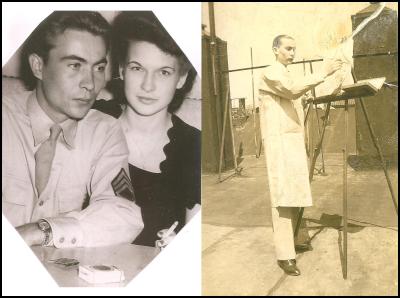
Click to enlarge
Dad was a man of peace, but if really coaxed, would recount his World War II capture of an old, ailing Nazi general. Dad's military service began in May 1941 as a private in the Ordnance branch at Fort Lewis, Washington, where he took up the trumpet as well. He was promoted to sergeant in 1942. In the fall of 1942, he was summoned to the US Army Air Corp (forerunner of the US Air Force) and became a pilot, after training in Hemet, California.

Click to enlarge
In 1943, Dad was reposted to Austria where he oversaw the repair of optical instruments. He also continued to play trumpet. He saw limited military action.
Toward the end of the war, he spent a month in the hospital in Europe (non-combat related) before returning to the US in November 1945 on the USS LeJeune, sailing from France.
Dad was eager to resume civilian life with Florence, the raven-haired beauty he'd met at a dance in their hometown of Larksville, Pennsylvania and married in December 1943. And to build a family.
Prior to the war, Dad had also served in Pennsylvania's Civilian Conservation Corps. CCC was run by the US Army with the assistance of non-military experts. Its projects included the construction of state parks, like World's End and Hickory Run with its glacial boulder field -- parks Dad and Mom later took the family to explore as children.
Mom spent some of the war years in New York working at RCA on war-related products and awaiting Dad's return from Europe. She thrived in the tempo of the city, was delighted by its shops and amusements, especially the Coney Island rollercoaster. Mom valued cheerful friends and loved to laugh -- long and hard.
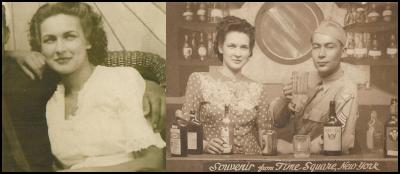
Click to enlarge
With the war over, Peter and Florence, now reunited in marriage, moved for a time between Newark, New Jersey, where the jobs were (building a family would take more money than painting masterpieces could provide), and northeast Pennsylvania where the family's roots were in the Russian and Lithuanian communities employed in the then-waning anthracite coal mining industry.
The US military constructed "barracks", heated with kerosene, in Newark for WWII vets and their young families -- where I spent my early years. It was a close, fun community. I rode a Hopalong Cassidy bike in those days with gun, holster and saddle bags.
There was one black family living in the barracks. Mom befriended their mother Gladys.
Dad was employed in New Jersey at Kearfott Corporation (then Kearfott Division General Precision Equipment Corporation) in the early 1950s while Mom nurtured the four Mazur children. She took us to Branch Brook Park to see the blossoms, and the guppies and frogs in the park's mossy ponds (my curious sister, to my mother's horror, slipping in one day). On trains downtown to shop at Bamberger's, and to ride the ceiling monorail at Kresge's. Into New York at Macy's to sit for silhouettes and photos with Santa and the Bunny. She gave us "permanents" and parties, and arranged our first television appearance on Junior Frolics, a cartoon show on Channel 13/WNJY in Newark hosted by "Uncle Fred Sayles". She read stories endlessly to us -- clearly sparking my career in journalism. Mom was an unselfish woman but always reserved enough of herself for herself to be beautiful.
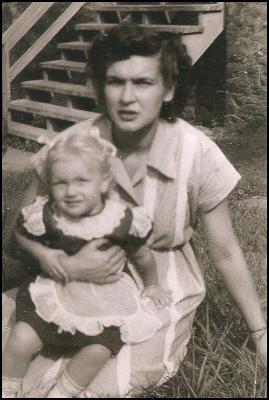
Click to enlarge
Mom and Dad were both huge football fans. Dad took me by the hand to my first live game in Newark at age five. I can still remember the cheers, cigars, climb up the bleachers and sense of vertigo looking down onto the field. Dad encouraged me to see creatively -- as he did -- with perspective, to look at shadow, texture, to love color. To think. . .

Click to enlarge
Dad was a graceful man with a certain focus and sincerity that fostered trust. So he just about succeeded in convincing me one snowless Christmas eve during a walk around the block that Santa was arriving by helicopter: "Listen, you can hear him coming!" -- as Mom set out gifts under the tree.
I was unaware of what demands there may have been on Dad's energy at the Kearfott plant but he did find time summer weekends to drive us to nearby lakes and to the Jersey Shore on day trips. The Nash Rambler was a tight squeeze and Mom insisted on bigger cars henceforth. We always took a pie, stopping off to visit my parents' friends living near the beach.
For a few weeks each summer my parents thoughtfully sent me and one of my sisters by bus to visit my maternal grandparents -- the Martins, who lived in Plymouth, adjacent to Larksville. They were lively personalities with family roots in Vilnius. And their backyard had trees loaded with peaches and cherries. The neighborhood children were blonde like me and my sister and we all found fascination wandering nearby fields investigating the creatures that dwelt within, catching grasshoppers and lightning bugs, etc.
Those were also delicious times of homegrown tomato sandwiches and potato roasts. Pickled pigs feet and other wierd Lithuanian aspics. Coffee! with milk and heaps of sugar. Lighting of sparklers at night from the upstairs porch. Singing songs around the player piano. And combing of the Pittston fabric yard for bargains followed by a parade in dresses Grandma designed for us adorned with lace from the famed Scranton mills.
With the1950s air raid drills, during which my classmates and I were instructed at Abington Avenue school in Newark to hide under our seats in the auditorium, there was an increasing sense that life in the city was getting complicated. So the Mazurs resettled in northeastern Pennsylvania where the world view was less cynical.
My parents enrolled me in a school in Kingston across the river from Wilkes-Barre with mostly Jewish students, who also went to Hebrew school at the end of each regular school day. Their parents had housekeepers I remember being amazed seeing my friend Susie Yudkovitz on television in the Ed Sullivan Show audience screaming wildly as Elvis Presley performed on stage. Then we moved to Plymouth where Jews were almost invisible in my school.
The Susquehanna River was a distinct orange in northeastern Pennsylvania from the anthracite coal mine runoff. But the eastern European culture that connected the towns along the river was more than life-sustaining.
Dad came from a family of 12 (10 children). He liked being near his mother and father, felt responsible since they were growing older. They had emigrated from eastern Galicia (Carpathian mountains) and spoke Russian.
Grandma's maiden name was Delet-Kanic. The origin of the name Delet-Kanic appears to be "De Lettre Koenig" -- the letter of the king. Grandma's family lived in Sanok and belonged to the Habsburg court. Grandma cooked savory east European food, recipes my mother also mastered.
Grandpa, whose spirited blue eyes and surname reflected roots in Mazuria, the lake region of what is today northern Poland, was retired from a life in mining and smoked a fragrant pipe.
Dad took a supervisory position at Eberhard Faber in Mountain Top, Pennsylvania in the late 1950s. It was every child's dream! As kids we had every pencil and paint imaginable.
Money became an increasing concern as the Mazur children grew, so Dad opened a jewelry and watchmaking business at home. At first he worked at night following his days at Eberhard Faber, from a "bench" in Mom's and Dad's bedroom. There was something sacred about the silence and blue of his eyes in the florescence of that space.
Then Dad built a shop adjacent to the house. He was known far and wide as a master of his craft and continued to work on watches until age 90.
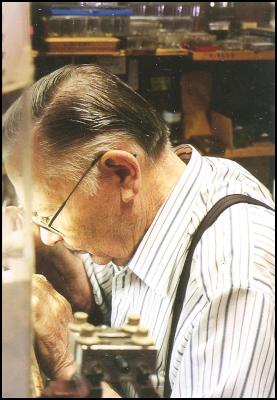
Click to enlarge
Dad was still a marvelous engraver in the 1960s. And he could also still sculpt, once creating a head of wax that brought me an A+ on a high school art project; the head remained on display for an extended time and was never returned. Dad and Mom also made and sold Austrian crystal beaded necklaces and earrings.
When the Mazur kids were college bound, Mom found employment again in factories, sewing dresses and upholstering furniture. The factory work nearly destroyed her hands as the mines had indeed ravaged her father's health, though Grandpa remained a powerfully built man with tremendous presence. And Mom's Lithuanian joie de vivre was unstoppable.
Mom was an organized woman and once told me she'd been asked to run for town mayor. Unions also sought her talent. As reported in 1972 in the local press at the time of the Agnes flood, Mom's factory was the first to be up and running due to her volunteer efforts and those of her co-workers.
I especially cherish the simple joys of growing up with Mom and Dad -- Dad making baskets from oatmeal containers for forages to Larksville mountain for huckleberries while Mom readied the pie crust. Mom's summer pies were always worth braving mosquito and spider bites. Dad's summer haircuts that John Sahag would have paused for. Drives to Harvey's Lake and Sandy Bottom beach, stopping at Sunset for buttered corn and Twin Kiss ice cream on the way home.
I loved Dad's creativity. His painting the house foyer an offbeat maroon and grey. Taking a potlid to create a scallop trim. His gorgeous cedar pencil-slat wall. These were not the compositions of his youth, but he hung the Old West oil he painted at age 18 on the opposite wall as a reminder. Ultimately, the applause he cared about was his family's.
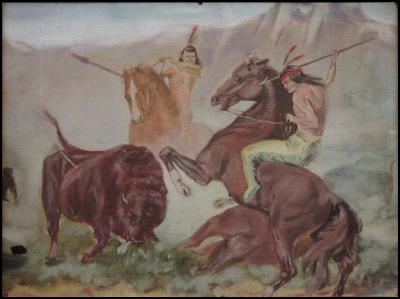
Peter Mazur -- Untitled, 1937Click to enlarge
Meanwhile, Mom had laughs painting-by-numbers!
Like Galileo's daughter, I was intrigued by Dad's projects and experiments. Detailed drawings of plans. Heating rubber washers for pinstriping pencils. Inventing a car alarm. . .
Each autumn Wyoming Valley, Pennsylvania morphed into football country as the athletic grandsons of the men who toiled in the mines took to the field. These were serious, not to be missed competitions. Mom was one of the most animated fans.
Local Pennsylvania winters were also serious with blizzards and six-foot snowfalls, which Mom thought nothing of shoveling and encouraged the kids to go out sleding in. My younger sister shared her zest for the snow
Both of my parents thrilled to spring's renewal and its blossoms. Mom had her herb and tomato garden. Dad had his fig trees.
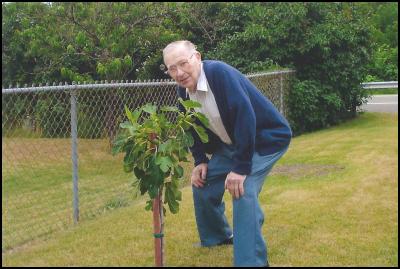
Click to enlarge
Dad once wrote to me:
"I'm
writing this Wednesday, 6:30 a.m.
It's real beautiful
outside.
The sun has risen and is shining.
The grass
is wet with dew. (I know cause my feet are all wet.)
The
air smells of freshness and as I breathe my mind is filled
with hope.
Our garden is beautiful, growing with leaps
and bounds."
AND
"To wake up in the morning and see out
your window a beautiful apple blossom bloom. . .
Don't
miss springtime.
Take time out to see.
Love. . ."
And they chose springtime to leave. . .
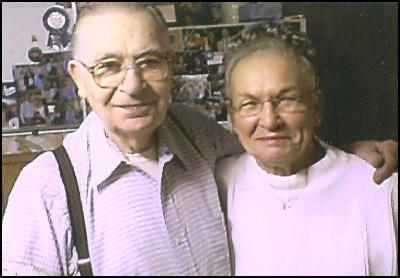
 Suzan Mazur
is the author of Altenberg
16: An Exposé of the Evolution Industry.
Her interest in evolution began with a flight from Nairobi
into Olduvai Gorge to interview the late paleoanthropologist
Mary Leakey. Because of ideological struggles, the
Kenyan-Tanzanian border was closed, and Leakey was the only
reason authorities in Dar es Salaam agreed to give landing
clearance. The meeting followed discovery by Leakey and her
team of the 3.6 million-year-old hominid footprints at
Laetoli. Suzan Mazur’s reports have since appeared in the
Financial Times, The Economist, Forbes, Newsday,
Philadelphia Inquirer, Archaeology, Connoisseur, Omni and
others, as well as on PBS, CBC and MBC. She has been a guest
on McLaughlin, Charlie Rose and various Fox Television News
programs. Email: sznmzr @
aol.com
Suzan Mazur
is the author of Altenberg
16: An Exposé of the Evolution Industry.
Her interest in evolution began with a flight from Nairobi
into Olduvai Gorge to interview the late paleoanthropologist
Mary Leakey. Because of ideological struggles, the
Kenyan-Tanzanian border was closed, and Leakey was the only
reason authorities in Dar es Salaam agreed to give landing
clearance. The meeting followed discovery by Leakey and her
team of the 3.6 million-year-old hominid footprints at
Laetoli. Suzan Mazur’s reports have since appeared in the
Financial Times, The Economist, Forbes, Newsday,
Philadelphia Inquirer, Archaeology, Connoisseur, Omni and
others, as well as on PBS, CBC and MBC. She has been a guest
on McLaughlin, Charlie Rose and various Fox Television News
programs. Email: sznmzr @
aol.com


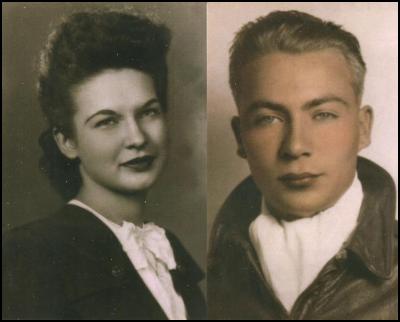
 Martin LeFevre - Meditations: Animal Encounters During Meditative States
Martin LeFevre - Meditations: Animal Encounters During Meditative States Ian Powell: Gisborne Hospital Senior Doctors Strike Highlights Important Health System Issues
Ian Powell: Gisborne Hospital Senior Doctors Strike Highlights Important Health System Issues Keith Rankin: Who, Neither Politician Nor Monarch, Executed 100,000 Civilians In A Single Night?
Keith Rankin: Who, Neither Politician Nor Monarch, Executed 100,000 Civilians In A Single Night? Eugene Doyle: Writing In The Time Of Genocide
Eugene Doyle: Writing In The Time Of Genocide Gordon Campbell: On Wealth Taxes And Capital Flight
Gordon Campbell: On Wealth Taxes And Capital Flight Ian Powell: Why New Zealand Should Recognise Palestine
Ian Powell: Why New Zealand Should Recognise Palestine